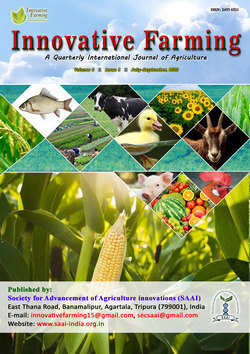
Low Cost Fish Feed Formulation with Nutritional Goldmine, Seri-Pupae Waste and Conventional Agricultural Byproducts for Betterment of Fish Farmer of Manipur
Tourangbam Shantibala*
College of Horticulture and Forestry, Pasighat, Central Agricultural University, Imphal, INDIA
Institute of Bioresources and Sustainable Development, Imphal, Department of Biotechnology, Government of India, Takyelpat, Manipur, INDIA
Gusheinzed Waikhom
Institute of Bioresources and Sustainable Development, Imphal, Department of Biotechnology, Government of India, Takyelpat, Manipur, INDIA
Gusheinzed Waikhom
Institute of Bioresources and Sustainable Development, Imphal, Department of Biotechnology, Government of India, Takyelpat, Manipur, INDIA
K. Mamocha Singh
College of Agriculture, Iroisemba, Central Agricultural University, Imphal, INDIA
B.N. Hazarika
College of Horticulture and Forestry, Pasighat, Central Agricultural University, Imphal, INDIA
DOI: NIL
Keywords: Defatted silkworm pupae waste, Fish feed formulation, Relative Growth Rate
Abstract
Manipur being a sericulture state, produces all the four traded silkworms viz. Eri, Mulberry, Muga and Tasar with a total production of 615.45 MT. Silkworm pupa which contributes 70% of cocoon biomass is a seri-waste. However, seri-waste, both spent and unspent pupae are complete nutritional package rich in protein (~41%), micro nutrients such as Iron (111 mg/ 100 gm), Magnesium (622 mg/ 100 gm), Calcium (~30.51 mg/ 100 gm) and also posses antioxidant property (IC 50%, 68μg/ml, eri pupae). The state have immense scope for aquaculture development but availability of fish feed is a limiting factor. Feed cost covers 60-80% of the total production of which protein cost accounts 15%. Therefore, efficacy of three different feed formulations (T1, T2 & T3) incorporated with defatted silkworm pupae waste (DSPW) at 25%, 50% and 75% respectively replacing Mustard oil cake (MOC) were evaluated including conventional feed as control on carp fingerlings (Labeo rohita). T3 showed significant effective growth rate indicating more than double the size (36.60 ± 0.56 gm) then the initial day (16.66 ± 0.56 gm) at the end of 90 days. Relative Growth Rate (RGR) of different formulated feeds indicated approximate increase of 45-50% with respect to the proportion of DSPW incorporation. Hence, fish feed of DSPW as protein supplement revealed double the relative growth rate compare to control feed. Low cost fish feed formulation with locally available materials are more cheaper than the conventional protein feed sources such as groundnut cake, fish meal and soybean meal, which do not permit profit maximization in aquaculture ventures. Hence, silk industry waste can be an alternative low-cost protein supplement for effective fish feed formulation in the state.
Downloads
not found
